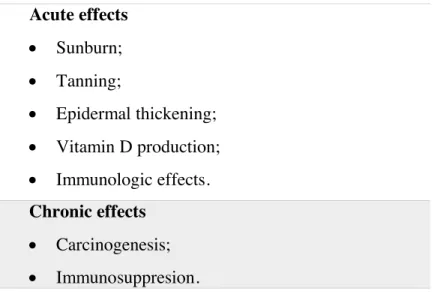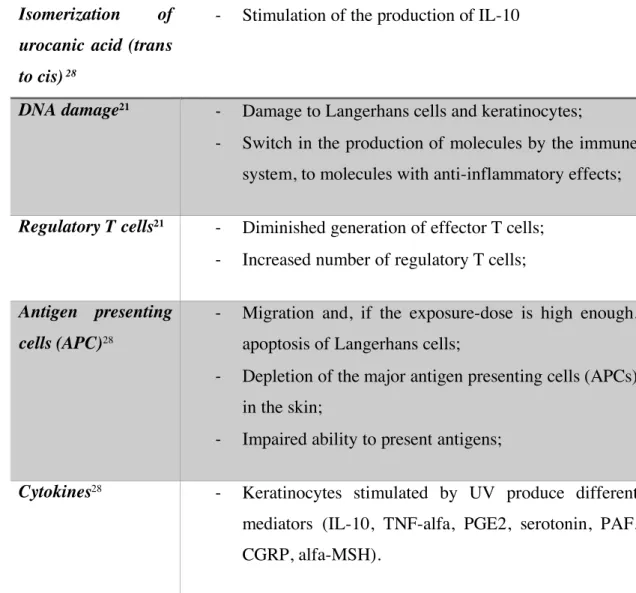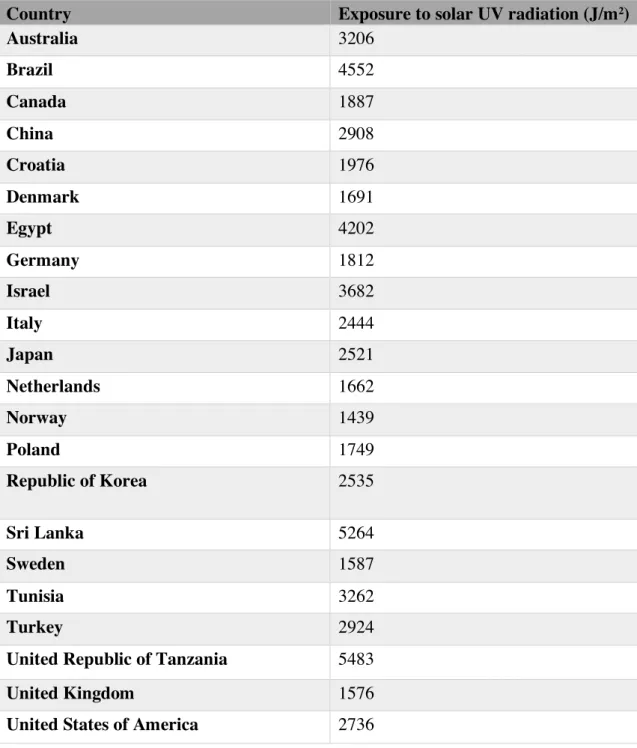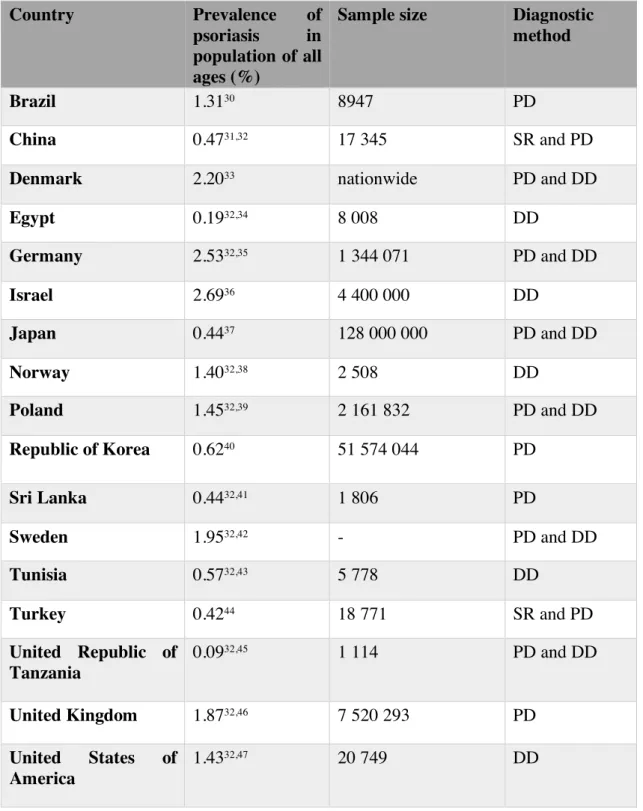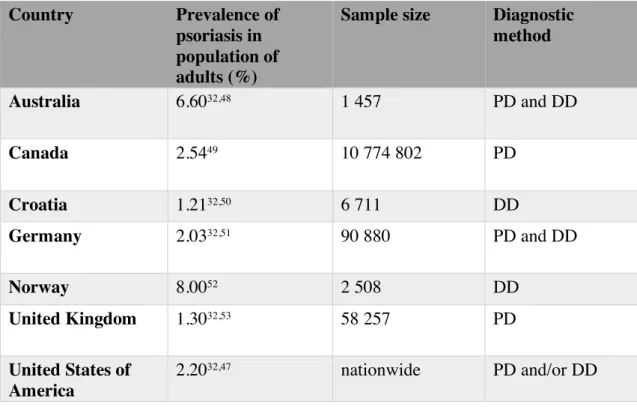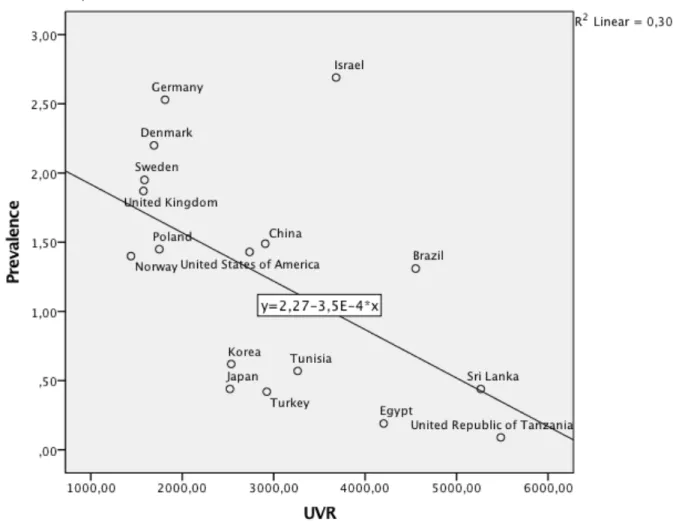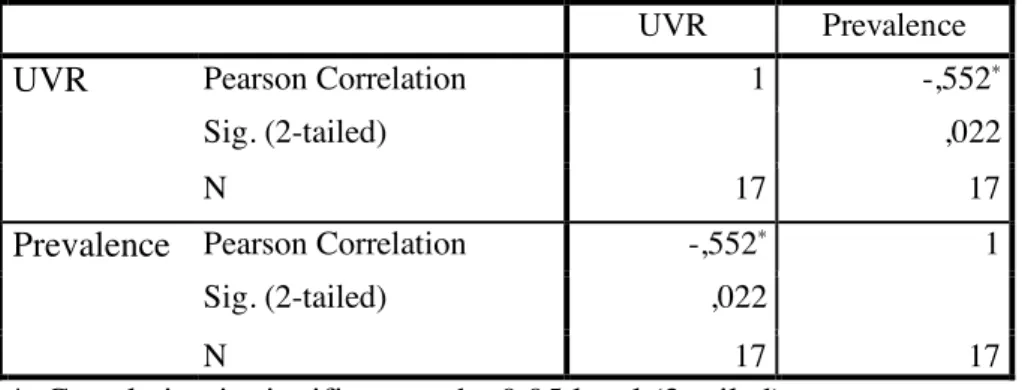Clínica Universitária de Dermatologia e Venerologia
The influence of ultraviolet radiation in
the prevalence of psoriasis
Clínica Universitária de Dermatologia e Venerologia
The influence of ultraviolet radiation in
the prevalence of psoriasis
Adriana Lourenço Caixinha
Orientado por:
Prof. Dr. João Borges da Costa
1.
ABSTRACT
Introduction: Psoriasis is a systemic disease that mainly affects the skin. It is a
common disease, with at least 100 million individuals affected worldwide and with higher prevalence rates in countries at higher latitudes. Although its etiology is not fully understood, it is considered a multifactorial disease, with great contribution of genetic factors and also epigenetic and environmental factors. Among the latter ones, ultraviolet radiation (UVR) is of special interest, as its effects are exploited in the treatment of this disease. The amount of UVR exposure could be influencing the typical geographical distribution of psoriasis.
Objective: This paper aims to find a correlation between the prevalence of psoriasis
and UVR exposure.
Materials and methods: International estimates of ambient exposure to UVR, derived
from satellite measurements, and prevalence data from epidemiology surveys were used to develop a correlation analysis, using Pearson’s correlation factor.
Results: A negative Pearson’s correlation factor of -0.55 (p<.05) was obtained, with
a linear R2 of 0.304.
Conclusions: Our findings suggest that populations of countries with higher UVR
exposure, present a lower prevalence of this disease. The effect size for psoriasis’ prevalence indicates that UVR may account for a considerable portion (30%) of the variability in psoriasis’ prevalence.
Keywords: psoriasis, prevalence, ultraviolet radiation, epidemiology, climate.
The present work expresses the opinion of the author and not that of the Faculty of Medicine of the University of Lisbon.
1. RESUMO
Introdução: A psoríase é uma doença sistémica que afeta primordialmente a pele. É
uma doença comum, afetando mais de 100 milhões de indivíduos por todo o mundo, que apresenta uma prevalência superior em países com maior latitude. Apesar da sua etiologia não se encontrar totalmente esclarecida, é considerada uma doença multifatorial, com grande contribuição de fatores genéticos, mas também de fatores epigenéticos e ambientais. Entre estes últimos, a radiação ultravioleta apresenta particular interesse, uma vez que se trata de um fator climático que é também usado na abordagem terapêutica desta doença, podendo contribuir para a distribuição geográfica característica da psoríase.
Objetivo: O objetivo deste trabalho é verificar se existe uma correlação entre a
prevalência da psoríase e a exposição a radiação ultravioleta.
Materiais e métodos: Estimativas internacionais dos níveis de exposição ambiental de
radiação ultravioleta, obtidos por medições via satélite, e dados de prevalência provenientes de estudos epidemiológicos, são confrontados num estudo de correlação estatística, utilizando o coeficiente de correlação de Pearson.
Resultados: Foi obtida uma correlação negativa de -0.55 (p<.05), com um valor de R2 de 0.304.
Conclusão: Os resultados obtidos sugerem que países com valores de exposição a
radiação ultravioleta superiores apresentam valores de prevalência de psoríase inferiores, com um ‘effect size’ que indica que a variação deste fator climático, pode ser responsável por 30% da variação da prevalência.
Palavras-chave: psoríase, prevalência, radiação ultravioleta, epidemiologia, clima
O presente trabalho exprime a opinião do autor e não da Faculdade de Medicina da Universidade de Lisboa.
2. TABLE OF CONTENTS
1. ABSTRACT ... 3 1. RESUMO ... 4 2. TABLE OF CONTENTS ... 5 3. INTRODUCTION ... 6 PATHOPHYSIOLOGY ... 6 ETIOLOGY ... 7 EPIDEMIOLOGY... 8CLIMATE AND PSORIASIS ... 8
UV RADIATION EFFECTS ... 8
4. RELEVANCE OF THE STUDIED SUBJECT... 11
5. MATERIALS AND METHODS ... 12
6. RESULTS ... 17
7. DISCUSSION ... 19
8. BIBLIOGRAPHY ... 22
3. INTRODUCTION
Psoriasis is a chronic, immune-mediated, systemic disease that mainly affects the skin and the joints1 and recent estimates suggest that at least 100 million individuals are affected worldwide.2
Although some controversy exists regarding the mild and moderate forms, severe psoriasis is associated with cardiovascular comorbidity.3,4 Cardiovascular diseases are the leading cause of death among these patients with a sevenfold increased risk of myocardial infarction.5 Furthermore it is associated to a great psychologic burden, with lower quality of life and greater work impairment.6
Following a report from 2010, that estimated psoriasis to account for 1 050 660 years of healthy life lost globally, twice as many years as for acute hepatitis C, the WHO recognized the urgent need to raise awareness and to fight stigmatization suffered by psoriatic patients leading to the release of a global report on psoriasis, in 2016.7
Pathophysiology
Psoriasis pathology involves a cross-talk between innate and adaptive immunity, involving keratinocytes, dendritic cells (DCs) and T-cells.8
The abnormalities observed range from antigen presentation, differentiation of T helper cell populations and enhanced IL-17 response.9
-‐ Innate immune system
External insults to a healthy skin result in the release of self-nucleotides from the skin, that form complexes with the epidermis-produced antimicrobial peptide IL-37 (cathelicidin - cAMP). These complexes are recognized by toll-like receptor (TLR) on the surface of plasmacytoid dendritic cells (pDCs) and are subsequently intracellularly degraded. If the cAMP binds to a foreign DNA, an interferon (IFN)-driven response is triggered. In the case of psoriatic skin, adding to the fact that production of cAMP is exacerbated, the IFN-driven response is also triggered following the formation of
host-DNA/cAMP complexes. These two factors result in a pathologic cascade of activation of myeloid dendritic cells, via the release of IFN-alfa and TNF-alfa.
-‐ IL 12/23 axis
The activated myeloid DCs produce TNF-alfa, IL12 and IL23, which stimulate Th1, Th22 and Th17. Th17 plays a central role in psoriasis, by producing IL-17 that acts on keratinocytes, and induces them to proliferate and produce TNF and CCL20 (a chemotactic for T-cells and DCs). This results in the recruitment of additional inflammatory cells to the skin.
-‐ Antigen presentation
CD8+ T-cells also play a role, and are activated by pDCs presenting antigens, both in the lymph nodes (naïve T-cells) and in the dermis (memory resident T cells). Subsequently, in the epidermis, the activated CD8+ T-cells encounter the Major histocompatibility complex class I (MHC-I) on the surface of keratinocytes and trigger the local release of soluble factors – cytokines, chemokines and innate immune mediators.
Etiology
The etiology of psoriasis is complex and not completely understood, but there is clear evidence of an important genetic component, with concordance rates of 70% and 20%, for monozygotic and dizygotic twins, respectively.9 Furthermore, more than 40 susceptibility loci associated, mostly regarding genes that code proteins with immune functions are involved in the pathophysiologic processes described above.,10
In addition to the existence of this genetic predisposition, documented investigations regarding phenomena of DNA methylation, histone modification and non-coding RNA; as well as evidence of association to among others, UV radiation, medication, alcohol intake, smoking, diet and obesity, infection and mental stress have led to the belief that the interplay between genetic, epigenetic and environmental factors determines the development of this disease 11
Epidemiology
Reviews on the global epidemiology of psoriasis have revealed an apparent upward trend in the prevalence of this disease, but they have also systematically shown a significant variation of its occurrence according to the geographic region, with higher prevalence rates reported in countries at higher latitudes – “equator effect”.12 This effect is not yet understood, and part of this variation might be attributed to the different methodologies used in the available studies concerning the epidemiology of psoriasis, such as definition of prevalence, case definition of psoriasis, different population ages and sampling techniques. Nevertheless, genetic and epigenetic factors, historic migration patterns, as well as climate factors may contribute to this geographic variation.13
Climate and psoriasis
Regarding the influence of climate on psoriasis, a global investigation that sought to correlate latitude with psoriasis’ prevalence, was conducted, by Jacobson et al., but only demonstrated a non-significant correlation between the two.14 Although the statistical analysis of this latter study had been contested (and later defended by its author), no further investigations at a global scale were performed.15,16
In another recent study, concerning the population of the United Kingdom, a significant correlation between latitude and prevalence was found.17
It has also been suggested that, as in other diseases, climatic confounders and not latitude itself, may account for these geographic variations.13 One factor of particular interest is UV radiation, a climate factor that depends, among others, on latitude. It is important to look closely at the relationships between these different factors when studying their correlation with psoriasis.
UV radiation effects
Ultraviolet radiation is part of the spectrum of electromagnetic radiation emitted by the sun. According to its biologic effects, it can be divided into UVA (wavelength
Since 100% of UVC and 90% of UVB are absorbed by atmospheric ozone, UVA and UVB are the solar ultraviolet radiation of importance to human health.18
Table 1 Effects of ultraviolet radiation on the skin19
UVR is responsible for different effects on the skin (Table 1). Sun exposure demonstrates a U-shaped exposure-disease association, with minimal exposure doses being required for induction of synthesis of vitamin D, which is essential for locomotor system health; and high exposure being associated to skin cancer.20
Regarding the immunosuppressive effects of UVR, which have been extensively studied since their first description in the late 1970s, a relatively new discipline of biomedical research, namely photoimmunology, has been developed. 21 Although the field first emerged due to the clinical observation of UVR-induced skin cancer, its further growth has also facilitated the development of standardized, efficient, phototherapies for disorders, such as psoriasis, atopic dermatitis and T-cell skin lymphoma.22–24
Furthermore, a beneficial effect of UVR on the prevalence of some autoimmune disorders, such as type 1 diabetes and multiple sclerosis has been proposed. These effects can be attributed to UVR-induced immunomodulatory mechanisms explained below.25
Immunosuppression by UV radiation involves multiple pathways, Langerhans cells and regulatory T-cells being its main orchestrators.26 Both UVA and UVB contribute to immunosuppression and it is believed that they have synergetic effects, given the fact that sunlight is more suppressive than either one of them alone.27 Here we summarize some in table 2. Acute effects • Sunburn; • Tanning; • Epidermal thickening; • Vitamin D production; • Immunologic effects. Chronic effects • Carcinogenesis; • Immunosuppresion.
Table 2 Immunosuppressive effects of ultraviolet radiation on skin
Isomerization of
urocanic acid (trans
to cis) 28
-‐ Stimulation of the production of IL-10
DNA damage21 -‐ Damage to Langerhans cells and keratinocytes;
-‐ Switch in the production of molecules by the immune system, to molecules with anti-inflammatory effects;
Regulatory T cells21 -‐ Diminished generation of effector T cells;
-‐ Increased number of regulatory T cells;
Antigen presenting
cells (APC)28
-‐ Migration and, if the exposure-dose is high enough, apoptosis of Langerhans cells;
-‐ Depletion of the major antigen presenting cells (APCs) in the skin;
-‐ Impaired ability to present antigens;
Cytokines28 -‐ Keratinocytes stimulated by UV produce different
mediators (IL-10, TNF-alfa, PGE2, serotonin, PAF, CGRP, alfa-MSH).
Considering that the above summarized immunologic effects of UVR antagonize the ones that underlie psoriasis’ pathophysiology, other than explaining the efficacy of UV based treatments for psoriasis, it is reasonable to hypothesize the existence of an association between psoriasis’ prevalence and UVR exposure.
4. RELEVANCE OF THE STUDIED SUBJECT
Knowledge concerning the epidemiology and etiology of diseases is of undeniable importance to allow its adequate management. Even though psoriasis has been gaining more attention in recent years, it is still a disease with knowledge gaps.
In light of the most recent findings, it is obvious that genetics play a central role in psoriasis’ etiology, but more research is needed to conclude whether other factors also are involved.
The aim of this study is to investigate a potential association between UV radiation and the prevalence of psoriasis in different countries.
Although a negative correlation between the two variables would not prove causality, it would be an important step towards this direction. In that case this study can bring us closer to determining the role of UVR in psoriasis pathogenesis, either as an independent necessary factor or as a factor influencing only populations that share a common genetic pool.
5. MATERIALS AND METHODS
This study used only previously published data. Estimates of international ambient erythemally weighted UVR, derived from satellite measurements and prevalence data from epidemiology surveys were used to develop a correlation analysis.
Literature research and inclusion and exclusion criteria
Articles were identified using the PubMed database and by following reference lists. The search was performed using the keywords "Psoriasis/epidemiology"[Mesh] AND "Prevalence"[Mesh] NOT "Arthritis, Psoriatic"[Mesh] (385 articles). Given the paucity of data, no restrictions regarding date of studies were applied.
Titles and abstracts were reviewed for exclusion criteria, which were: • Non-English full-text available;
• Studies concerning only psoriatic arthritis;
• Correlation studies with no epidemiologic data regarding psoriasis’ prevalence;
• Only self-reported based prevalence studies;
• Prevalence studies in sub-populations not likely to be representative of the general population or of non-country regions.
To assess the quality of the studies, only studies with data reporting methods differentiating diagnostic method, age of the subjects, year of study and sample size were considered.
Data extraction
From each included article, the following data was extracted: prevalence estimate age-related (all ages, adults and children), diagnostic method, year of study and sample size.
From the selected articles, data was combined to eliminate duplicates.
When more than one prevalence estimate value was available for a specific geographic region, the most recent one was chosen.
Prevalence data in population of all ages was obtained from 17 different countries, for adults from 7 different countries and for children from 5 different countries.
UV radiation exposure
The data concerning the UV radiation was obtained through the WHO database, in the category “Public health and environment”, in the “Ultraviolet radiation” folder, under the topic “Exposure to solar ultraviolet radiation – data by country”. The data (table 3) was originally collected by WHO in order to evaluate the burden of disease resulting from exposure to ultraviolet radiation.
The estimates are population-weighted average daily ambient UVR level, calculated from satellite data, and the used unit is J/m2. It concerns the period between 1997-2003 for selected countries.29
Statistical analyses
Statistical analyses of the relationship between the prevalence and climate data were performed using SPSS to compute the Pearson’s correlation factor.
Table 3 Exposure to solar ultraviolet radiation -‐ data by country.29 Abbreviations: UV, ultraviolet.
Country Exposure to solar UV radiation (J/m2)
Australia 3206 Brazil 4552 Canada 1887 China 2908 Croatia 1976 Denmark 1691 Egypt 4202 Germany 1812 Israel 3682 Italy 2444 Japan 2521 Netherlands 1662 Norway 1439 Poland 1749 Republic of Korea 2535 Sri Lanka 5264 Sweden 1587 Tunisia 3262 Turkey 2924
United Republic of Tanzania 5483
United Kingdom 1576
United States of America 2736
Table 4 Prevalence of psoriasis in population of all ages.
PD, physician diagnose; DD, dermatologist diagnose; SR, self-‐reported.
Country Prevalence of psoriasis in population of all ages (%)
Sample size Diagnostic method
Brazil 1.3130 8947 PD
China 0.4731,32 17 345 SR and PD
Denmark 2.2033 nationwide PD and DD
Egypt 0.1932,34 8 008 DD Germany 2.5332,35 1 344 071 PD and DD Israel 2.6936 4 400 000 DD Japan 0.4437 128 000 000 PD and DD Norway 1.4032,38 2 508 DD Poland 1.4532,39 2 161 832 PD and DD Republic of Korea 0.6240 51 574 044 PD Sri Lanka 0.4432,41 1 806 PD Sweden 1.9532,42 - PD and DD Tunisia 0.5732,43 5 778 DD Turkey 0.4244 18 771 SR and PD United Republic of Tanzania 0.0932,45 1 114 PD and DD United Kingdom 1.8732,46 7 520 293 PD United States of America 1.4332,47 20 749 DD
Table 5 Prevalence of psoriasis in population of adults.
PD, physician diagnose; DD, dermatologist diagnose.
Table 6 Prevalence of psoriasis in population of children.
PD, physician diagnose; DD, dermatologist diagnose
Country Prevalence of psoriasis in population of adults (%)
Sample size Diagnostic method Australia 6.6032,48 1 457 PD and DD Canada 2.5449 10 774 802 PD Croatia 1.2132,50 6 711 DD Germany 2.0332,51 90 880 PD and DD Norway 8.0052 2 508 DD United Kingdom 1.3032,53 58 257 PD United States of America 2.2032,47 nationwide PD and/or DD Country Prevalence of psoriasis in population of children (%)
Sample size Diagnostic method Egypt 0.0632,54 6162 DD Germany 0.4532,55 293 181 PD and DD Italy 0.2032,56 145 233 PD Netherlands 0.1757 - PD and DD United States of America 0.1358 4 300 000 PD and DD
6. RESULTS
Prevalence of psoriasis in population of all ages
Estimates of psoriasis’ prevalence were obtained from 17 different countries.
The prevalence of psoriasis in studies with participants of all ages ranged from 0.09% (Republic of Tanzania)45 and 2.69% (Israel)36 (Table 4).
In Europe, estimate prevalence rates varied between 1.40% (Norway)38 and 2.53% (Germany)35. In Asia, rates ranged between 0.42% (Turkey)44 and 2.69% (Israel)36. Estimates in Africa ranged between 0.09% in the Republic of Tanzania45 and 0.57% in Tunisia43. For the continents of North and South America only two countries were included: 1.43% (USA)47 and 1.31% (Brazil)30.
No studies from Oceania were identified.
Prevalence of psoriasis in population of adults
Data from 7 different countries was obtained. In Europe, prevalence ranged between 1.21% (Croatia)50 and 8% (Norway)52. Data from Australia revealed a prevalence of 6.6%48. In North America, prevalence ranged from 2.20% (USA)47 to 2.54% (Canada)49. No data from South America, Asia or Africa was found. (Table 5)
Prevalence of psoriasis in population of children
Data was identified from 5 countries only, ranging from 0.06% (Egypt)54 to 0.45% (Germany)55. (Table 6).
Relationship between UVR and prevalence rates
We examined this relationship, using Pearson’s correlation factor and linear regression. The data regarding adult and children populations is too scarce and did not allow us to perform a linear regression analysis.
As for the populations of all ages, a negative correlation factor of -0.55 was obtained, with a linear R2 of 0.304.
Figure 1 Relationship between ultraviolet radiation and prevalence of psoriasis in population of all ages.
7. DISCUSSION
In this analysis, a Pearson correlation was conducted to examine the relationship between the median UVR exposure of countries and the respective prevalence of psoriasis in populations of all ages. Prevalence of psoriasis was negatively related to UVR, r (17)= -.55, p<.05. These findings suggest that populations of countries with higher UVR exposure, present a lower prevalence of this disease. The effect size for psoriasis prevalence (r2 =.30) suggests that UVR accounts for a considerable portion (30%) of the variability in psoriasis’ prevalence. Although not statistically considered an outlier, a point that is out-of-rule is visible in the scatterplot graphic, namely Israel. Excluding this value, the correlation results in a higher negative value (r (16) = -.70, p < .01). On the other hand, it is important to consider the possibility that this surprisingly high prevalence value may be a consequence of the north European origin of a great part of this country’s population, demonstrating the importance of genetic factors.
This is the first study, as able as we were to search in the literature, evaluating the relationship between ambient erythemally weighted UVR and the prevalence of psoriasis. Two previous studies have sought to establish a correlation between climate factors and psoriasis.14,17 These studies focused on latitude, instead of UVR. Although latitude provides a rough approximation of the global variation in UVR, due to the elliptical shape of the Earth’s orbit, there is a 7% difference in intensity between the hemispheres for any level of latitude.59 Also, clearer skies in the southern hemisphere can increase this difference up to 10-15%.60 Thus, UVR itself could be a more suitable factor to asses this relationship.
Although the earliest of the two studies, which was made on a global scale, showed no statistically significant correlation,14 the most recent one, focusing only on the UK population, showed a stronger correlation than the one found in this article.17 This could suggest that UVR may influence the prevalence of psoriasis, but only within a population from the same genetic pool.
Studying the scatterplot graphic, it is also possible to identify a cluster in data, formed by European countries, where the highest rates in prevalence are observed. This further supports the fact that genetics is a more important factor than climate.
There are important limitations to this analysis, regarding both data on prevalence and radiation. Firstly, the available data lacks standardized definitions for the prevalence estimate (point-estimate, period or lifetime estimate) and for the study design adopted by each study, which may decrease the liability of this data. Furthermore, there is a paucity of data from certain global regions, such as South America and Oceania. Regarding African countries, the existing studies date from the sixties and only describe the incidence of the disease and thus meets this study´s exclusion criteria.61–63 This paucity of data not only decreases the strength of a global study, but also renders the comparison of the influence of UVR among genetically homogenous populations (United Kingdom with Canada, Australia or New Zealand) impossible.
Regarding the UVR data, it is known that its effect on human health depend on the amount and type of radiation impinging on the body.60 The amount and type of radiation depend on factors such as sun elevation, latitude, altitude, cloud cover, atmospheric ozone concentration and ground reflection.59
In order to study its effects, ambient UVR can be weighted using erythemal response function to give biologically effective UVR, expressed as joules per square meter, minimal erythemal dose (MED), standard erythemal dose (SED) or the solar UV index.59
MED depends on skin type and corresponds to the required UVR dose to produce a barely perceptible erythema in people with skin type 1 (200 Jm-2); SED is the erythemally weighted measure of radiant exposure equivalent to 100 Jm-2 and is independent of skin type. Solar UV index is a tool developed to arise public-awareness of the risks of UVR and adopt protective measures.60
Although it is possible to use annual ambient erythemally weighted UVR as a measure of a population exposure (as done in this study) its use does not overcome the biases created by not considering the true individual UVR exposure experience, which, for most subjects, is believed to vary from 5 to 15% of the total ambient UVR.59 On the other hand, there is no efficient method to account for the individual differences on behavior and clothing among different countries.
Another limitation is the fact that different areas of a specific country, have different UVR exposure levels. Using the median of the whole country can be a source of biases, especially in countries with areas as vast as the USA and China.
In conclusion UVR seems to be significantly negatively correlated to psoriasis prevalence in populations of all ages. Nevertheless, there are important limitations. Despite the presence of these biases, the results obtained demonstrate that there is substrate for further investigation on psoriasis epidemiology.
In order to expand knowledge in this area, new, standardized methodologic age-specific studies on global psoriasis prevalence are required in order to allow us to understand the causes and patterns of psoriasis, prioritize research needs, investigate the natural history of the disease and identify environmental factors influencing psoriasis, such as UVR.
8. BIBLIOGRAPHY
1. Boehncke W-H, Schön MP. Psoriasis. Lancet. 2015;386(9997):983-994.
doi:10.1016/S0140-6736(14)61909-7
2. WHO. Global Report on Psoriasis. World Heal Organ 48.
2016;(70):DOI:10.1128/AAC.03728-14.
3. Dowlatshahi EA, Kavousi M, Nijsten T, et al. Psoriasis is not associated with atherosclerosis and incident cardiovascular events: the Rotterdam Study. J Invest
Dermatol. 2013;133(10):2347-2354. doi:10.1038/jid.2013.131
4. Hu S, Lan C-CE, Hu SC-S, Lan C-CE. Psoriasis and Cardiovascular Comorbidities: Focusing on Severe Vascular Events, Cardiovascular Risk Factors and Implications for Treatment. Int J Mol Sci. 2017;18(10):2211. doi:10.3390/ijms18102211
5. Yeung H, Takeshita J, Mehta NN, et al. Psoriasis Severity and the Prevalence of Major Medical Comorbidity. JAMA Dermatology. 2013;149(10):1173.
doi:10.1001/jamadermatol.2013.5015
6. Griffiths CEM, Jo S-J, Naldi L, et al. A multidimensional assessment of the burden of psoriasis: results from a multinational dermatologist and patient survey. Br J Dermatol. 2018;179(1):173-181. doi:10.1111/bjd.16332
7. IHME. The Global Burden of Disease: Generating Evidence, Guiding Policy.; 2013. doi:10.1007/s13398-014-0173-7.2
8. Greb JE et al. Psoriasis. Nat Rev Prim. 2016;2. doi:10.1007/978-3-319-59963-2_4
9. Harden JL, Krueger JG, Bowcock AM. The immunogenetics of Psoriasis: A
comprehensive review. J Autoimmun. 2015;64:66-73. doi:10.1016/j.jaut.2015.07.008
10. Mahil SK, Capon F, Barker JN. Genetics of Psoriasis. doi:10.1016/j.det.2014.09.001
11. Zeng J, Luo S, Huang Y, Lu Q. Critical role of environmental factors in the pathogenesis of psoriasis. J Dermatol. 2017;44(8):863-872. doi:10.1111/1346-8138.13806
psoriasis disease epidemiology: a workshop report. Br J Dermatol. 2017;177(1):e4-e7. doi:10.1111/bjd.15610
13. Enamandram M, Kimball AB. Psoriasis epidemiology: The interplay of genes and the environment. J Invest Dermatol. 2013;133(2):287-289.
doi:10.1038/jid.2012.434
14. Jacobson CC, Kumar S, Kimball AB. Latitude and psoriasis prevalence. J Am
Acad Dermatol. 2011;65(4):870-873. doi:10.1016/j.jaad.2009.05.047
15. Gutierrez E, Sanmartino C, Carrera O, Fraga A, Arce C. Psoriasis: Latitude does make a difference. J Am Acad Dermatol. 2017;77(2):e57.
doi:10.1016/j.jaad.2017.03.049
16. Hartman RI, Kimball AB. Psoriasis and latitude: Analytic approaches and future data needs. J Am Acad Dermatol. 2017;77(2):e59.
doi:10.1016/j.jaad.2017.04.1125
17. Springate DA, Parisi R, Kontopantelis E, Reeves D, Griffiths CEM, Ashcroft DM. Incidence, prevalence and mortality of patients with psoriasis: a U.K. population-based cohort study. Br J Dermatol. 2017;176(3):650-658. doi:10.1111/bjd.15021
18. Diffey BL. Sources and measurement of ultraviolet radiation. Methods. 2002;28(1):4-13. http://www.ncbi.nlm.nih.gov/pubmed/12231182. Accessed March 19, 2019.
19. Christensen L, Suggs A, Baron E. Ultraviolet Photobiology in Dermatology. In:
Advances in Experimental Medicine and Biology. Vol 996. ; 2017:89-104.
doi:10.1007/978-3-319-56017-5_8
20. Lucas RM, Ponsonby A-L. Ultraviolet radiation and health: friend and foe. Med J
Aust. 177(11-12):594-598. http://www.ncbi.nlm.nih.gov/pubmed/12463975.
Accessed March 19, 2019.
21. Elmets CA, Cala CM, Xu H. Photoimmunology. Dermatol Clin. 2014;32(3):277-290. doi:10.1016/j.det.2014.03.005
22. González Maglio DH, Paz ML, Leoni J. Sunlight Effects on Immune System: Is There Something Else in addition to UV-Induced Immunosuppression? Biomed
Res Int. 2016;2016. doi:10.1155/2016/1934518
23. Fernández-de-Misa R, Hernández-Machín B, Servitje O, et al. First-line
Dermatol. 2018;43(2):137-143. doi:10.1111/ced.13256
24. Grewe M, Bruijnzeel-Koomen CA, Schöpf E, et al. A role for Th1 and Th2 cells in the immunopathogenesis of atopic dermatitis. Immunol Today.
1998;19(8):359-361. http://www.ncbi.nlm.nih.gov/pubmed/9709503. Accessed March 19, 2019.
25. Staples JA, Ponsonby A-L, Lim LL-Y, McMichael AJ. Ecologic analysis of some immune-related disorders, including type 1 diabetes, in Australia: latitude, regional ultraviolet radiation, and disease prevalence. Environ Health Perspect. 2003;111(4):518-523. doi:10.1289/ehp.5941
26. Vieyra-Garcia PA, Wolf P. From Early Immunomodulatory Triggers to Immunosuppressive Outcome: Therapeutic Implications of the Complex Interplay Between the Wavebands of Sunlight and the Skin. Front Med. 2018;5:232. doi:10.3389/fmed.2018.00232
27. Poon TSC, Barnetson RSC, Halliday GM. Sunlight-Induced Immunosuppression in Humans Is Initially Because of UVB, Then UVA, Followed by Interactive Effects. J Invest Dermatol. 2005;125(4):840-846.
doi:10.1111/j.0022-202X.2005.23894.x
28. Schwarz T. Mechanisms of UV-induced immunosuppression. Keio J Med. 2005;54(4):165-171. http://www.ncbi.nlm.nih.gov/pubmed/16452825. Accessed March 14, 2019.
29. WHO. GHO | By category | Exposure to solar ultraviolet (UV) radiation - Data by country. WHO. http://apps.who.int/gho/data/view.main.35300. Accessed May 31, 2019.
30. Romiti R, Amone M, Menter A, Miot HA. Prevalence of psoriasis in Brazil – a geographical survey. Int J Dermatol. 2017;56(8):e167-e168.
doi:10.1111/ijd.13604
31. Ding X, Wang T, Shen Y, et al. Prevalence of psoriasis in China: a population-based study in six cities. Eur J Dermatol. 22(5):663-667.
doi:10.1684/ejd.2012.1802
32. Michalek IM, Loring B, John SM. A systematic review of worldwide
epidemiology of psoriasis. J Eur Acad Dermatology Venereol. 2017;31(2):205-212. doi:10.1111/jdv.13854
of Psoriasis in Denmark. Acta Derm Venereol. 2017;97(7):808-812. doi:10.2340/00015555-2672
34. Abdel-Hafez K, Abdel-Aty MA, Hofny ERM. Prevalence of skin diseases in rural areas of Assiut Governorate, Upper Egypt. Int J Dermatol.
2003;42(11):887-892. http://www.ncbi.nlm.nih.gov/pubmed/14636205. Accessed February 16, 2019.
35. Schaefer I, Rustenbach S, Radtke M, Augustin J, Glaeske G AM. Epidemiologie der Psoriasis in Deutschland – Auswertung von Sekund€ar- daten einer
gesetzlichen Krankenversicherung. Gesundheitswesen. 2011;73:308–313. http://apps.webofknowledge.com/InboundService.do?product=WOS&Func=Fra me&DestFail=http%253A%252F%252Fwww.webofknowledge.com%253FDest Params%253DUT%25253DWOS%2525253A000273723600358%252526custo mersID%25253Datyponcel%252526smartRedirect%25253Dyes%252526action %25253Dretrieve%252526mode%252. Accessed February 16, 2019.
36. Shalom G, Zisman D, Babaev M, et al. Psoriasis in Israel: demographic, epidemiology, and healthcare services utilization. Int J Dermatol. 2018;57(9):1068-1074. doi:10.1111/ijd.14130
37. Kubota K, Kamijima Y, Sato T, et al. Epidemiology of psoriasis and
palmoplantar pustulosis: a nationwide study using the Japanese national claims database. BMJ Open. 2015;5(1):e006450-e006450. doi:10.1136/bmjopen-2014-006450
38. Falk ES, Vandbakk O. Prevalence of psoriasis in a Norwegian Lapp population.
Acta Derm Venereol Suppl (Stockh). 1993;182:6-9.
http://www.ncbi.nlm.nih.gov/pubmed/8237241. Accessed February 16, 2019. 39. Borzęcki A, Dudra-Jastrzębska M, Sajdak-Wojtaluk A. Epidemiologia łuszczycy
w rejonie województwa lubelskiego w latach 2005-2009. Clin Dermatology /
Dermatologia Klin. 2012;14(4):149-153.
http://search.ebscohost.com/login.aspx?direct=true&db=a9h&AN=85331438&sit e=eds-live.
40. Han J, Lee J, Han K, et al. Epidemiology and Medication Trends in Patients with Psoriasis: A Nationwide Population-based Cohort Study from Korea. Acta Derm
Venereol. 2018;98(4):396-400. doi:10.2340/00015555-2877
Prevalence of skin diseases in suburban Sri Lanka. Ceylon Med J.
2000;45(3):123-128. http://www.ncbi.nlm.nih.gov/pubmed/11192992. Accessed February 16, 2019.
42. British Association of Dermatologists. SLTSET. British Journal of Dermatology. Vol 167. Blackwell Science; 2012.
https://insights.ovid.com/british- dermatology/bjdr/2012/08/000/prevalence-doctor-diagnosed-psoriasis-psoriatic/79/00002300. Accessed February 16, 2019.
43. European Academy of Dermatology and Venereology. NFKKSZFG. Journal of
the European Academy of Dermatology and Venereology : JEADV. Vol 21.
Elsevier Science Publishers; 1992. https://insights.ovid.com/european-academy-
dermatology-venereology/jeadv/2007/07/001/epidemiology-psoriasis-tunisia/106/00042358. Accessed February 16, 2019.
44. Çakır N, Pamuk ÖN, Derviş E, et al. The prevalences of some rheumatic diseases in western Turkey: Havsa study. Rheumatol Int. 2012;32(4):895-908.
doi:10.1007/s00296-010-1699-4
45. Gibbs S. Skin disease and socioeconomic conditions in rural Africa: Tanzania.
Int J Dermatol. 1996;35(9):633-639.
http://www.ncbi.nlm.nih.gov/pubmed/8876289. Accessed February 16, 2019. 46. Seminara NM, Abuabara K, Shin DB, et al. Validity of The Health Improvement
Network (THIN) for the study of psoriasis. Br J Dermatol. 2011;164(3):no-no. doi:10.1111/j.1365-2133.2010.10134.x
47. Vanderpuye-Orgle J, Zhao Y, Lu J, et al. Evaluating the economic burden of psoriasis in the United States. J Am Acad Dermatol. 2015;72(6):961-967.e5. doi:10.1016/J.JAAD.2015.02.1099
48. Plunkett A, Merlin K, Gill D, Zuo Y, Jolley D, Marks R. The frequency of common nonmalignant skin conditions in adults in central Victoria, Australia. Int
J Dermatol. 1999;38(12):901-908. doi:10.1046/j.1365-4362.1999.00856.x
49. Eder L, Widdifield J, Rosen CF, et al. Trends in the prevalence and incidence of psoriasis and psoriatic arthritis in Ontario, Canada: A population-based study.
Arthritis Care Res (Hoboken). September 2018. doi:10.1002/acr.23743
50. Barisić-Drusko V, Paljan D, Kansky A, Vujasinović S. Prevalence of psoriasis in Croatia. Acta Derm Venereol Suppl (Stockh). 1989;146:178-179.
51. Augustin M, Herberger K, Hintzen S, Heigel H, Franzke N, Schäfer I. Prevalence of skin lesions and need for treatment in a cohort of 90 880 workers. Br J
Dermatol. 2011;165(4):865-873. doi:10.1111/j.1365-2133.2011.10436.x
52. Modalsli EH, Snekvik I, Åsvold BO, Romundstad PR, Naldi L, Saunes M. Validity of Self-Reported Psoriasis in a General Population: The HUNT Study, Norway. J Invest Dermatol. 2016;136(1):323-325. doi:10.1038/JID.2015.386 53. O’Neill P, Kelly P. Postal questionnaire study of disability in the community
associated with psoriasis. BMJ. 1996;313(7062):919-921. doi:10.1136/BMJ.313.7062.919
54. El-Khateeb EA, Lotfi RA, Abdel-Aziz KM, El-Shiekh SE, El-Shiekh SE. Prevalences of skin diseases among primary schoolchildren in Damietta, Egypt.
Int J Dermatol. 2014;53(5):609-616. doi:10.1111/ijd.12335
55. Augustin M, Radtke MA, Glaeske G, et al. Epidemiology and Comorbidity in Children with Psoriasis and Atopic Eczema. Dermatology. 2015;231(1):35-40. doi:10.1159/000381913
56. Cantarutti A, Donà D, Visentin F, et al. Epidemiology of Frequently Occurring Skin Diseases in Italian Children from 2006 to 2012: A Retrospective,
Population-Based Study. Pediatr Dermatol. 2015;32(5):668-678. doi:10.1111/pde.12568
57. De Jager MEA, Van De Kerkhof PCM, De Jong EMGJ, Seyger MMB.
Epidemiology and prescribed treatments in childhood psoriasis: A survey among medical professionals. J Dermatolog Treat. 2009;20(5):254-258.
doi:10.1080/09546630902911847
58. Paller AS, Singh R, Cloutier M, et al. Prevalence of Psoriasis in Children and Adolescents in the United States: A Claims-Based Analysis. J Drugs Dermatol. 2018;17(2):187-194. http://www.ncbi.nlm.nih.gov/pubmed/29462227. Accessed March 14, 2019.
59. Lucas R, Mcmichael T, Smith W, et al. World Health Organization Public
Health and the Environment Geneva.; 2006.
https://apps.who.int/iris/bitstream/handle/10665/43505/9241594403_eng.pdf?seq uence=1. Accessed May 31, 2019.
60. World Health Organization, World Meteorological Organization UNEP& IC on N-IRP. Global Solar UV Index: a practical guide. World Heal Organ. 2002.
https://www.who.int/uv/publications/en/UVIGuide.pdf. Accessed May 31, 2019. 61. Leder RO, Farber EM. The variable incidence of psoriasis in sub-Saharan Africa.
Int J Dermatol. 1997;36(12):911-919. doi:10.1046/j.1365-4362.1997.00251.x
62. Ross CM. Skin disease in the Venda. S Afr Med J. 1966;40(14):302-308. http://www.ncbi.nlm.nih.gov/pubmed/4222749. Accessed May 31, 2019. 63. Shrank AB. A field survey in Nigeria. Trans St Johns Hosp Dermatol Soc.
9. ANNEXES
Figure 2 Correlation analyses between the two variables UVR and prevalence of psoriasis in population of all ages.
Abbreviations: UVR, ultraviolet radiation.
Figure 3 Descriptive statistics analysis of the data Correlations
UVR Prevalence
UVR Pearson Correlation 1 -,552*
Sig. (2-tailed) ,022
N 17 17
Prevalence Pearson Correlation -,552* 1
Sig. (2-tailed) ,022
N 17 17
*. Correlation is significant at the 0.05 level (2-tailed).
Descriptive Statistics
Mean Std. Deviation N
UVR 2936,6471 1306,00832 17
